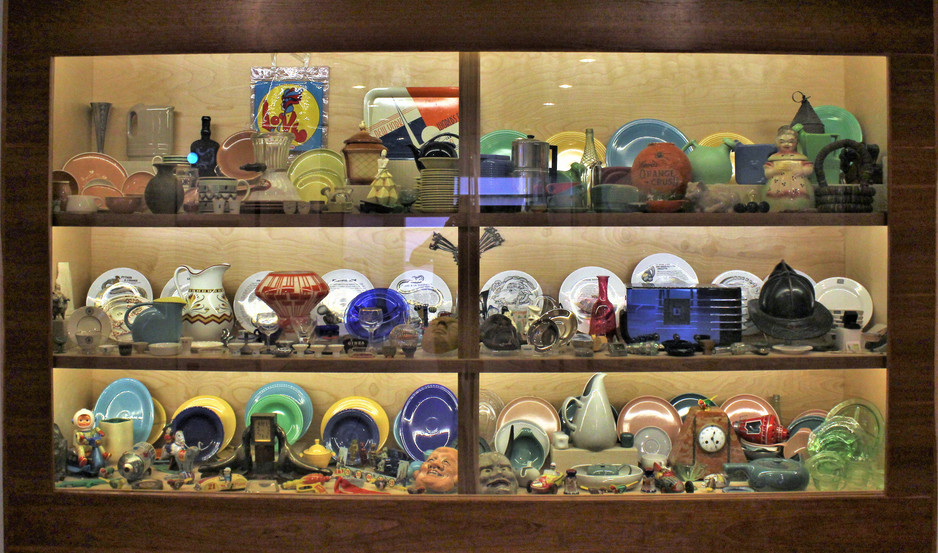Andy Warhol
- Tim Murphy

- Sep 3, 2018
- 6 min read
Updated: Apr 24, 2021
Andy Warhol was born Andrew Warhola on August 6, 1928 in Pittsburgh, Pennsylvania. He was the youngest son of Andrej and Julia Warhola, immigrants from eastern Slovakia. The family lived in Soho, an uptown neighborhood which overlooks the Pittsburgh from the southeast.
Throughout his childhood, Andy suffered from bouts of chorea (also known St. Vitus’ Dance), a nervous disorder which causes involuntary spasms of the extremities. This disease kept Andy bed-ridden for weeks on end. The downtime, however, allowed young Warhol to explore his interest in art. He sketched cartoons, read Hollywood magazines, and when Warhol was 9, he was gifted his first camera. Realizing their son’s potential as an artist, Andy’s parents enrolled him in art classes at The Carnegie Institute. He attended the school from 1937 to 1941.

In 1945, Warhol was admitted to Carnegie Institute of Technology’s Department of Painting and Design. With more materials at his disposal, Warhol started to experiment with the blotted-line technique, a method of illustration he would use later in his commercial work during the 1950s. According to the Warhol Museum, the blotted-line technique:
“…combines drawing with basic printmaking. Warhol began by copying a line drawing in pencil on a
piece of non-absorbent paper, such as tracing paper. Next, he hinged this piece of paper to a second sheet
of more absorbent paper by taping their edges together on one side. With a fountain pen, Warhol inked
over a small section of the drawn lines. He then transferred the ink onto the second sheet by folding along
the hinge and lightly pressing or “blotting” the two papers together. The process resulted in the dotted,
broken, and delicate lines that are characteristic of Warhol’s illustrations.”
Warhol graduated from the Carnegie Institute in 1949 with a Bachelor of Fine Arts in Pictorial Design. He moved to New York City later that year to explore employment opportunities. He found work in commercial advertising by drawing shoes for Glamour Magazine. His sketches took on a greater appreciation outside of the advertising world, as his work was soon displayed in prominent contemporary art galleries across the city. In 1952, only a few years after the launch of his professional career, Warhol displayed his first solo exhibit at the Hugo Gallery, named “Fifteen Drawings Based on the Writings of Truman Capote.”
After finding considerable success in the galleries, Warhol took to writing books. He published collections of his own illustrations—such as A Gold Book, 25 Cats Named Sam and One Blue Pussy, and Wild Raspberries—and popularized Do-It-Yourself adult coloring books. In 1956, Warhol embarked on a two-month trip to Europe and Asia, hoping to find cultural references and artistic techniques he could add to his repertoire.

In 1961, Warhol began to work in his most famous genre: Pop art. The Pop Art Movement started in the United Kingdom during the mid-1950s and made its way over to the United States a few years later (Warhol was one of the firsts to embrace this new art form in America). Pop art, by definition, is based on popular culture and mass media. The portrayal of recognizable people and objects reached a broader target audience than “traditional” artistic forms. While pop art gathered a greater appreciation from and was more applicable to the layman, critics scorned the movement as being a shallow, glorified form of commercialization and an unnecessary proponent of capitalism. But to pop art advocates, that was the point—to express nonconformity to traditional artistic views. The movement was all about perception and finding the art in everyday items and images, ideals Warhol would come to master.
In 1962, fellow pop artist Max Cohn introduced Warhol to the photo silkscreen technique. This method took an enlarged, cropped image and photographically burned it to a silkscreen canvas using a light-sensitive emulsion. This created a stencil that allowed ink to pass through open areas of the screen. Examples of this medium can be seen in Warhol’s celebrity portraits (like Jackie Kennedy and Marilyn Monroe) and Campbell’s Soup Cans.
Andy Warhol was not only a revolutionary in the field of art, but also social awareness. Warhol was a LGBT icon, at a time when non-heterosexual expression was a difficult concept to grasp and hardly tolerated. Warhol shamelessly allowed his sexual orientation to influence his art, which implored his admirers and critics to explore the complexity of sexuality. Warhol displayed many of his erotic works in underground galleries, since they were too raunchy or “openly gay” for public exhibition.
In 1964, Warhol established his famous “Silver Factory” studio on New York’s E. 47th Street. The interior of the workspace was painted silver and covered in aluminum foil (thus the name). Warhol’s studio soon became a mecca for admirers of postmodernism and “superstars”—Warhol’s name for the charismatic personalities in his circle and a nod at the Hollywood star system. All those who visited the Silver Factory were instructed by Warhol to pose in front of a camera for three minutes. Warhol collected nearly 500 of these short films, strung them together, and ran them all in slow motion, creating a “dreamlike stillness.” These are collectively known today as the Screen Tests, arguably his most ingenious motion picture production.
Warhol’s Screen Test project peaked his interest in the film industry. In 1963, Warhol produced Sleep, a six-hour-long movie of his then-boyfriend, John Giorno, sleeping. Warhol created this piece as part of the “anti-film” movement, which embraced concepts of Dadaism. In 1964, Warhol created Empire, an eight-hour long, black-and-white film of the Empire State Building. The fixed camera angle, slow frames-per-second, and ever-changing sunlight exposure creates a peculiar—and rather ominous—effect as the building is slowly consumed by darkness. It is considered Warhol’s most influential work by critics. His most commercially-successful publication, however, was The Chelsea Girls—an unpredictable and sexually-explicit premiere of some of Warhol’s superstars shot at The Chelsea Hotel in New York. Newsweek called it “One of the most powerful, outrageous, relevant, and noticeable movies anyone anywhere has made!”

Warhol conscripted the talent of The Velvet Underground to create soundtracks for his films and converted his Factory into a rehearsal studio for the band. Warhol took on a “managerial” role with the band: assisting with sound checks, setting up the rehearsal stage, and encouraging the use of instrumental minimalism which would compliment his films. Warhol also produced the first album cover for Velvet Underground and Nico—the iconic banana with vinyl skin. The tip of the banana read, “Peel slowly and see,” revealing a pink fruit underneath.
On June 3, 1968, an assassination attempt was carried out on Warhol by Valerie Solanas. Solanas, a former collaborator with Warhol, was founding member of S.C.U.M. (Society for Cutting Up Men), a radical feminist group “dedicated to the elimination of the male sex.” She entered Warhol’s studio at 33 Union Square West and shot him point-blank with a revolver. Warhol was severely wounded and was rushed to the hospital where he underwent numerous surgeries. He nearly escaped death, but was suffered from the physical and emotional scars for the rest of his life.
Warhol quickly returned to the art scene following his recovery, not missing a beat. He founded Interview magazine in 1969 and continued his work in the music and film industries. In 1971, he designed the cover for The Rolling Stones’ album Sticky Fingers (Mick Jagger was a good friend of Warhol’s). In 1984, he was featured in The Cars’ music video for “Hello Again.” The pop culture icon also appeared on segments of Saturday Night Live and starred in his own MTV show, Andy Warhol’s Fifteen Minutes.
Andy Warhol died on February 22, 1987, at the age 58, due to complications from gallbladder surgery. He is buried in the St. John the Baptist Byzantine Catholic Cemetery in the Pittsburgh suburb of Bethel Park. In his will, Warhol wished for the majority of his possessions to be sold at auction, the proceeds of which would be used to establish the Andy Warhol Foundation for the advancement of visual arts. The auction raised more than $20 million. Much of that money went into the construction of the Andy Warhol Museum, which opened in Pittsburgh, Pennsylvania, on May 13, 1994.

The Andy Warhol Museum is housed in a seven-story, 88,000 square-foot renovated warehouse and is the largest museum dedicated to a single artist in North America. The museum holds nearly 13,000 articles of Warhol’s, including 900 paintings, 4,000 photographs, and 60 feature films. Visitors are encouraged to start from the seventh floor and work their way down. The top four floors explore Warhol’s life, what influenced his creations, and how his artistic mediums changed over time. The third floor is the Archives Center, which displays a collection of over 500,000 personal items belonging to Warhol. These objects were Warhol’s primary sources of inspiration. The second floor is the Special Exhibition Gallery. At the time of my visit, this floor displayed “Adman: Warhol before Pop”—an exhibit of Warhol’s advertising work from the ‘50s and ‘60s (Note: this exhibit was removed as of September 2, 2018). The main floor contains the entrance space and gift shop, while the Underground level is the location of the Conservation Lab and “Factory” workshop, which offers classes about Warhol’s art-making techniques.
Andy Warhol was certainly one of the most innovative and talented artists in American history. His ability to take ordinary objects and turn them into fine art on a consistent basis was nothing short of incredible. The multi-faceted approach he undertook with the visual arts allowed him to excel in diverse artistic mediums and make the avant-garde conventional. He was truly a visionary and an inspiration to modern art.
What are your opinions on Andy Warhol? Let us know in the comments below!
For more information on the The Andy Warhol Museum, CLICK HERE!
























